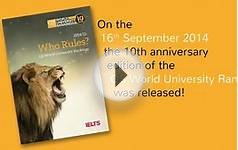 The primary aim of the QS World University Rankings 2013 is to help students make more informed comparisons between their international study options. The rankings compare the world's top 800 institutions across broad areas that are of interest to prospective students: research, teaching, employability and international outlook. They are compiled using the following six criteria, each of which is given a different percentage weighting (quoted in brackets):
The primary aim of the QS World University Rankings 2013 is to help students make more informed comparisons between their international study options. The rankings compare the world's top 800 institutions across broad areas that are of interest to prospective students: research, teaching, employability and international outlook. They are compiled using the following six criteria, each of which is given a different percentage weighting (quoted in brackets):
Academic reputation (40%)
Academic reputation is measured via a global survey, asking academics to tell us where the best work is currently taking place within their field of expertise.
This year the rankings draw on 62, 094 responses globally, collated over three years. Only participants' most recent responses are used, and they cannot vote for their own institution. Regional weightings are applied to counter any discrepancies in response rates.
The major advantage of measuring academic quality in this way is that it gives a more equal weighting to different discipline areas than citation counts. Whereas citation rates are far higher in, say, biomedical sciences than they are in English literature, the academic reputation survey weights responses from academics in different fields equally.
It also gives students a sense of the consensus of opinion among those who are by definition experts. Academics may not be well positioned to comment on teaching standards at other institutions, but it is clearly well within their remit to have a view on where the most significant research is currently taking place within their field.
Employer reputation (10%)
The employer reputation indicator is also based on a global survey, this time taking in 27, 900 responses. The survey asks graduate employers to identify the universities that in their view produce the best graduates. It is unique among international rankings.
The purpose of the survey is to give students a better sense of how universities are viewed in the job market. A higher weighting is given to votes for universities from outside of their own country, so it's useful in helping to identify universities with a reputation that extends beyond their national borders.
Research citations (20%)
Research citations are sourced from Scopus, the world's most comprehensive citations database. They measure how often a university's published research is mentioned in academic literature, factored against the size of its faculty.
Student-to-faculty ratio (20%)
A simple measure of the number of academic staff employed for every student enrolled. In the absence of an international standard by which to measure teaching quality, it provides an insight into which universities are well equipped to provide small class sizes and a good degree of individual supervision.








